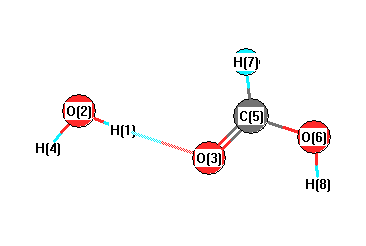Vibrational Frequencies calculated at CCSD(T)/3-21G
| Mode Number |
Symmetry |
Frequency
(cm-1) |
Scaled Frequency
(cm-1) |
IR Intensities
(km mol-1) |
Raman Act
(Å4/u) |
Dep P |
Dep U |
|---|
| 18 |
A |
3569 |
3535 |
|
|
|
|
| 17 |
A |
3444 |
3412 |
|
|
|
|
| 16 |
A |
3431 |
3398 |
|
|
|
|
| 15 |
A |
3167 |
3138 |
|
|
|
|
| 14 |
A |
1748 |
1732 |
|
|
|
|
| 13 |
A |
1662 |
1646 |
|
|
|
|
| 12 |
A |
1409 |
1396 |
|
|
|
|
| 11 |
A |
1351 |
1338 |
|
|
|
|
| 10 |
A |
1122 |
1112 |
|
|
|
|
| 9 |
A |
1067 |
1057 |
|
|
|
|
| 8 |
A |
675 |
669 |
|
|
|
|
| 7 |
A |
627 |
621 |
|
|
|
|
| 6 |
A |
601 |
596 |
|
|
|
|
| 5 |
A |
323 |
320 |
|
|
|
|
| 4 |
A |
273 |
270 |
|
|
|
|
| 3 |
A |
221 |
219 |
|
|
|
|
| 2 |
A |
158 |
157 |
|
|
|
|
| 1 |
A |
146 |
145 |
|
|
|
|
Unscaled Zero Point Vibrational Energy (zpe) 12496.8 cm
-1
Scaled (by 0.9906) Zero Point Vibrational Energy (zpe) 12379.3 cm
-1
See section
III.C.1 List or set vibrational scaling factors
to change the scale factors used here.
See section
III.C.2
Calculate a vibrational scaling factor for a given set of molecules
to determine the least squares best scaling factor.
Charges, Dipole, Quadrupole and Polarizability
Charges from optimized geometry at CCSD(T)/3-21G
Charges (e)
| Number |
Element |
Mulliken |
CHELPG |
AIM |
ESP |
| 1 |
H |
0.396 |
|
|
|
| 2 |
O |
-0.754 |
|
|
|
| 3 |
O |
-0.610 |
|
|
|
| 4 |
H |
0.357 |
|
|
|
| 5 |
C |
0.590 |
|
|
|
| 6 |
O |
-0.679 |
|
|
|
| 7 |
H |
0.288 |
|
|
|
| 8 |
H |
0.410 |
|
|
|
Electric dipole moments
Electric dipole components in Debye
(What's a Debye? See section
VII.A.3)
| |
x |
y |
z |
Total |
| |
1.193 |
0.483 |
1.662 |
2.102 |
| CHELPG |
|
|
|
|
| AIM |
|
|
|
|
| ESP |
|
|
|
|
Electric Quadrupole moment
Quadrupole components in D Å
Polarizabilities
Components of the polarizability tensor.
Units are
Å
3 (Angstrom cubed)
Change units.
| |
x |
y |
z |
| x |
0.000 |
0.000 |
0.000 |
| y |
0.000 |
0.000 |
0.000 |
| z |
0.000 |
0.000 |
0.000 |
<r2> (average value of r
2) Å
2
| <r2> |
117.461 |
| (<r2>)1/2 |
10.838 |
